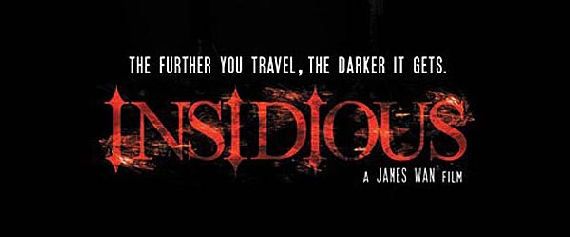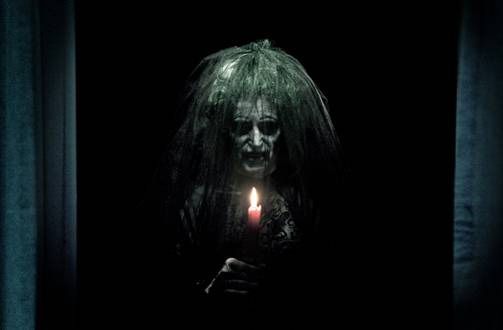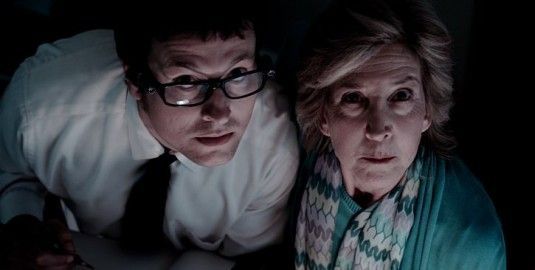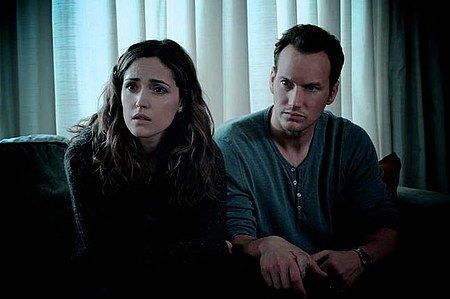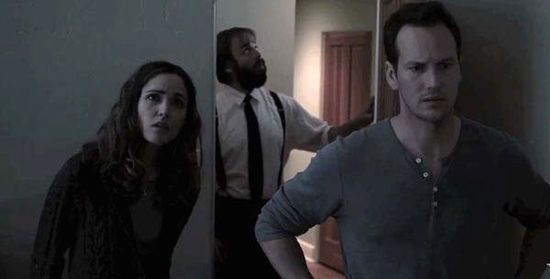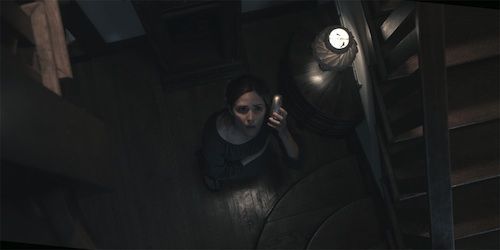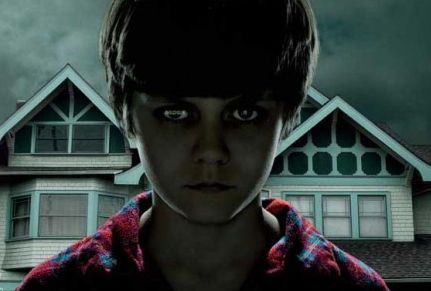Last week, I had the opportunity to see Insidious, the new horror film from director James Wan and writer Leigh Whannell, the creative team behind Saw. Going into the film, I didn't have too many expectations, knowing only that it was a traditional haunted house movie with plenty of jump scares and other time-tested tricks for making the audience pee their pants. I figured it would be no big deal for a tough, pragmatic guy like me.
Walking out of the theater two hours later, I couldn't have been happier to see the sunny city streets of Chicago. Not only did Insidious scare me, it terrified me. I don't know if others will have the same reaction, but I hope they do, because it was an awesome experience.
Yesterday, I was lucky enough to talk with Wan and Whannell during a press tour in support of the film. During our interview, I talked to the pair about the old-school style of Insidious, what they thought about horror movie remakes, and why they may be done with the horror genre for a while. Check out our interview below.
--
SR: First off, let me just say congratulations, because Insidious scared the crap out of me. So, my hat’s off to you guys.
JW: You have to write the review for the film then!
SR: As I was watching the movie, I was reminded of Poltergeist. I know that that was an inspiration, and, James, that you even said you wanted this to be the Poltergeist of this generation. Why do you single that film out as inspiration?
JW: For me, it was the first horror film I’ve ever seen, and I think it scarred me for life. It’s one movie - because I saw it at a very young age - which had a huge impact on me. I remember seeing the film in the theater - and I was really young - maybe five, six, or seven - and cowering behind the seat in front of me during the sequence when the clown doll is sitting on the chair and the little boy was trying to throw his coat over it. That just freaked the heck out of me, and ever since then I’ve had this really freakish obsession with creepy clown dolls. And so, the doll found its way into Saw, and I’ve always been terrified of the haunted house genre because of that movie.
So, in a lot of ways, this is kind of me harking back to that, but I would actually say I kind of harked back further than that because 'Poltergeist' itself was influenced by all the other great haunted house movies that came before it like 'The Haunting', 'The Innocent', and all the great movies like that.
LW: Yeah, 'The Changeling'.
JW: 'The Changeling', yeah.
SR: Insidious is an original script, which is refreshing, because there are a lot of remakes now - especially remakes of slasher films. What’s your take on remakes in general?
LW: I hate them.
JW: Leigh and I have different points of view. Similar, but different.
LW: Yeah, I mean, some of my favorite films are remakes: 'The Thing', 'The Fly'. But, I think we’re talking about two different things when we talk about those films and the remakes of today, the remakes of films like 'Texas Chainsaw Massacre' and 'Friday the 13th' and 'Nightmare on Elm Street'.
I think that, if you look at 'The Thing', 'The Fly', 'Invasion of the Body Snatchers', the remakes of those films were all taking something that was done so long ago… I mean, they didn’t even have color when they made [the original] 'The Fly' and 'The Thing'. And so, there was so much new that they could do with it that they are radically different films. You can’t compare David Cronenberg’s 'The Fly' to the older version. I think that in those cases, a remake is justified. So, I won’t say that I just blanket hate them, or the very word 'remake,' I think that this current glut of horror remakes is kind of pointless because the films aren’t bringing anything new to it.
It’s fine for them to make it. It’s not hurting me, but I certainly wouldn’t want to write one of those remakes or be involved with one. After 'Saw', we got offered every horror remake under the sun, and I was just always thinking, “I don’t see how this could be interesting for me.”
JW: Yeah, I do agree with Leigh there. I don’t feel so strongly against remakes, but if I don’t like it, I guess I just don’t do it. It is what it is, you know? Hollywood is driven by the financial system, so if they think that it has a brand and people are going to go see it because it’s a recognizable property, they’re going to remake it, right?
And you know what, it’s a losing battle. There’s no point getting upset over it. The key thing for Leigh and I is to make the movies that we want to make, and we want to make original films. Our movies have bits of homage to certain films, but we still want it to have our own take. So, you know, I may one day want to do a remake, but, if I were to do it, I want to be able to bring my own stamp to it. I want to make it different and fresh and do something that we haven’t already seen.
There’s really no reason to rehash something that you’ve already seen, and that’s part of the reason why I never directed any of those 'Saw' sequels, because I felt like, “I already did it with the first one,” and I didn’t want to repeat myself there unless I could have brought something different to it.
SR: With Saw, you guys were the creative force behind the most popular horror franchise in history. What’s your collaborative process like? How do you work together?
LW: We have a great process because we met at film school, and so we have this long history of friendship and kind of mucking around and making videos before we started getting into the more serious realm of actual filmmaking.
We tend to get together and talk about ideas, and once we have an idea that we both like - and that’s the key word, “both” – because usually one of us will have an idea, but the other one might not be as into it…
JW: By that, he means that I will throw him an idea and he will just shoot it down.
LW: But when we have an idea that we’re both into, it’s great and we both lock into it and we start talking about it and then I go off and write. I give James the script and he gives me ideas and feedback and we talk about it, so it’s really collaborative.
JW: Yeah, that’s what we did on 'Saw', and that’s what we did on our second movie, 'Dead Silence' as well, and that’s what we definitely did on 'Insidious'. You know, it’s a real back and forth process, and by the end of it, we don’t really remember who started what.
So, once Leigh and I settle on an overall concept, and where the film will possibly go, I just kind of let him go off and do his thing, you know, and give him the freedom to write the film. I just have so much trust that he can go off and write something really great, and then, you know, if it’s not that great, I just go “Leigh, hey, maybe tweak this here.”
LW: Then I go on a rampage…
JW: [Laughter] Yeah, but you know, he did a fantastic job with 'Insidious' and that’s part of the reason why I was very fortunate to get the actors I did because they read the script and they were very impressed by it, and they wanted to come play with us, despite the fact that, you know, we weren’t really paying anyone any money on this film because it was so low-budget.
SR: That’s interesting, because being a low-budget film, you’re sort of going back to your roots in independent film. And then you have Oren Peli and the Paranormal Activity team as producers as well. Why are you so much more passionate about independent film?
JW: Between 'Saw' and 'Paranormal Activity', along with the 'Blair Witch Project', it’s been proven time and time again that the scariest movies are ones that are made outside of the studio system, where you have the control to say, “You know what? I’m not going to open the movie with a big, scary action set piece. I’m just going to slowly build characters and get you sucked into the family, get you liking the characters before things start to happen."
If I was to do this movie through the studio system, it would have been a very different film. Would it have been a worse or a better film? I don’t know, I cannot say. But, I’d like to think that having the creative freedom that Leigh and I have to make it this way, to make it for a price, and with producers that really support us and trust us…we felt that that was the best way to tell this movie.
LW: It’s all about the story you’re telling. Certain stories need the resources of a studio. If you’re telling a story about a giant robot war in outer space, you’re going to need the money and the resources most of the time to do it justice. But with this particular film, it’s not the type of film that needs any of that. It’s best to do it outside of the system, do it low-key. You don’t need big effects or anything that can’t be done for a price.
JW: And I think the financial restraint really pushes me as a director to be more creative with the way I shoot the film, because the last act of this film, without giving it away, could have become some huge CGI crazy movie. But, because we didn’t have the money, I love that I have to be more creative with how I create this particular world.
--
Read the rest of our interview with the Insidious team...
SR: It was a really interesting practical set in the last third of the movie. That whole last sequence really separates Insidious from what might be a sort of conventional haunted house movie. And it is kind of uniquely “your thing.” You can see your guys’ imprint in that last third especially.
JW: Yeah, that’s what Leigh and I actually really thrive on. People either love that, or they’re polarized by how strange we tend to make our movies. But we kind of have to do that to be different. If you don’t do that, if you don’t bring something different to it, or put your own stamp to it, you’re just rehashing the same kind of movie again and again and again. And it’s really not much better than a remake.
SR: Leigh, I’m going to ask you about your script, because you’re acting in the movie as well and your character and your partner in the film bring a little bit of levity to the script. As I was watching, I thought “Oh my God, this is so tense,” so thank you for injecting a little bit of humor in the movie. When you’re writing a horror movie script, how difficult is it to find that balance between something that’s terrifying on the paper, and a little bit of levity?
LW: It’s tough, because you don’t want to tip the balance of the film in one direction, you know? Suddenly shoehorning some moments of levity in there can become a problem if you went too far, and that was something we had to watch both in the scriptwriting and on the set so that it didn’t suddenly seem like half the movie was quite serious and then you didn’t want the Men in Black to show up and start tossing out zingers.
So I had to carefully calibrate it, and I think James did a great job finding just the right amount in the editing. And it was written that way, too. I tried not to make it too broad, more of a subtle oneupsmanship between the two guys. But it’s interesting, I think the ghost hunter characters get bigger laughs in this film than they would in another film because by the time they come into the film, the audience is so tense…
JW: So dead serious, yeah…
LW: …that it’s almost like somebody that’s been beaten up so badly that the tiniest push would send them over, you know? It’s like, by the time you get to the middle you’re on a knife’s edge so much that just a couple of little lines here and there get a big reaction, so it seems bigger than it is.
But actually, you know, the ghost hunter guys are pretty subtle, they’re not too broad, but I’m glad you liked it, because that was the intention. To give the audience a place to relieve some tension, chill out for a little bit, and then get back into it.
SR: I’ve always wondered this about horror directors: You’re telling your actors to react to this demon, or some abstract concept, and there’s so many elements that go into it – sound design, camera work, editing – that it’s hard for them to know what it’s going to look like in the end for me as a viewer. So, how do you create an environment on set where people are really in the moment and terrified of what is supposed to be happening to them?
JW: That’s a very good question because it is very tricky to pull the right kind of performances from your actors. Firstly, your actors need to trust you as a director, but normally, I think you just need to have an open communication between the actors and the director. I think the director needs to really paint his or her vision to the cast and let them know the kind of mood that he or she is making. I think that’s very important.
When we were on set, one of the things I tried to do is to kind of talk my actors through the scene, but at the same time let them know how I plan to shoot the film and just give them an insight into the way I’m thinking, so that when they’re acting out their scene, they can kind of see it in their minds’ eyes. I think it’s really important to set the tone and the mood for a movie like this, that’s supposed to be creepy - you really need to be able to paint a very clear picture for the actors.
If they were acting in front of a green screen, it would be even worse, you know, where you’re reacting to a tennis ball hanging there. So that’s one reason too why I did not want to shoot this film on a set in a studio, I wanted to shoot it on real live locations so there’s that authenticity to it.
You know, every little small decision that I make really funnels back to how I would direct the actors and the environment that I would create for the actors. You know, working with my production designer, saying, “The demon is going to look like this,” okay? And then maybe not tell my actors until the demon shows up that day, and then I try and capture that on camera. So just little things like that.
The really sort of sad thing is the boy, Dalton, played by Ty Simpkins in the movie, he was so terrified - he was like 8 or 9 years old. Just about every single scene he has in the film, besides the start of the movie, was with a particular nasty, scary character, right? A demonic character. And he was terrified of him. Because, man, if you think that thing is scary on screen, imagine being an eight-year-old kid having to stand next to this thing all painted up in the darkness.
And you know, I would have to work with him and go, you know, “This isn’t real.” And sometimes, I would have to work with Ty and kind of go the opposite way, and go “You know what, in this scene, I really need him to break out and cry here.” Then, I would try and find some way, without scaring the kid too much, to extract that out of him. Then, when I would yell cut, I’d go “See Ty, that wasn’t so bad, was it?” and he’s like balling his eyes out.
LW: Years of therapy he’s going to need.
JW: [Laughter] Years of therapy, yeah. I remember one moment he was starting to lighten up and starting to have fun, and I was like, “Oh man, that’s not the effect I want.” [Laughter] So I went up to Ty and said, “You know Ty, after we shoot this scene, the next thing we’re shooting is that monster character chasing after you.” His eyes just started tearing up and I said, “Roll camera.”
LW: You bastard. You’re a monster.
SR: [Laughter] So manipulative.
LW: He’s like Sam Peckinpah.
JW: But what I did, is I would also take him on certain days to the makeup trailer and show him, “Look, it’s just an actor done up in makeup.” And he got to play with the makeup and get to apply some of the makeup to the actor playing the demon, who just happened to be the composer of the movie as well.
SR: That’s interesting, because the music really adds to the intensity of the film. It’s all strings and organs, and it makes you feel so tense.
JW: Yeah, and part of the reason why I wanted to go for that was that it’s really my throwback to classic old-school horror filmmaking. Today’s horror films are almost very electronica sounding, like very hip and cool and rock and roll. And I thought that that was wrong for 'Insidious'.
SR: Well, they’re telling me to wrap it up, so if you guys wouldn’t mind, let me know what your upcoming projects are, either independently or together.
JW: I’m in the midst of working on a script that I’m thinking of producing. It’s another haunted house-esque movie, which I love, and I came up with a really cool angle and twist for it. It’s called House of Horror. Because I’ve already done a haunted house movie, I didn’t want to do it again, so I didn’t want to direct it, so I found a really great director that’s attached to it. So, that’s something I’m working on, and I’m also in the process of looking for other future projects. Right now, I’m just so busy trying to get this movie out there.
LW: I’ve got a few different things I’ve been working on. There’s a sci-fi project that James and I have sort of been talking about for a while that we’re working on. I’ve written a comedy, a kid’s film, like an animated film that people will hopefully see one day. I think both of us are making a marked attempt to move away from the horror genre, not as a rejection of it, but simply because we want to show people that we can do things in other genres.
JW: Yeah, we felt like we’ve pretty much proven to ourselves by now that we can do horror.
LW: Yeah, so it would be great to do different genres. A sci-fi thing or a comedy.
JW: Leigh and I have always said that we’re not just horror fans, we’re movie fans.
--
And with that, I had to say my goodbyes to the Wan and Whannell. I wished them luck on Insidious on my way out, and I truly meant it.
I really think Insidious is a film that horror fans should see, because it offers all of the things you could ever want for in a haunted house-style movie without having to be explicit or overly gory. I really hope this film finds an audience and becomes the Poltergeist of this generation, just as James Wan thinks it might be.
Insidious will be in theaters on April 1, 2011.

